
The Dead Sea is a salt lake bordered by Jordan to the east and Israel and the West Bank to the west. It lies in the Jordan Rift Valley, and its main tributary is the Jordan River.

The Great Rift Valley is a series of contiguous geographic trenches, approximately 7,000 kilometres (4,300 mi) in total length, that runs from the Beqaa Valley in Lebanon which is in Asia to Mozambique in Southeast Africa. While the name continues in some usages, it is rarely used in geology as it is considered an imprecise merging of separate though related rift and fault systems.

The geography of Israel is very diverse, with desert conditions in the south, and snow-capped mountains in the north. Israel is located at the eastern end of the Mediterranean Sea in Western Asia. It is bounded to the north by Lebanon, the northeast by Syria, the east by Jordan and the West Bank, and to the southwest by Egypt. To the west of Israel is the Mediterranean Sea, which makes up the majority of Israel's 273 km (170 mi) coastline, and the Gaza Strip. Israel has a small coastline on the Red Sea in the south.
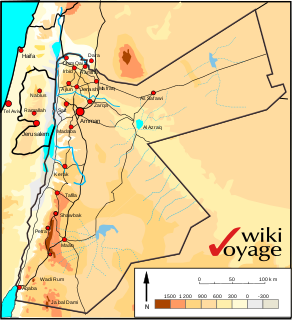
Jordan is situated geographically in Southwest Asia, south of Syria, west of Iraq, northwest of Saudi Arabia and east of Israel and the West Bank; politically, the area has also been referred to in the West as the Middle or Near East. The territory of Jordan now covers about 91,880 square kilometres (35,480 sq mi).
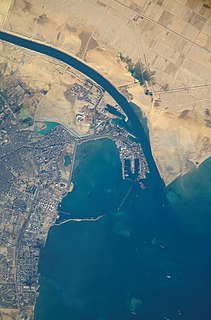
The Suez Canal is an artificial sea-level waterway in Egypt, connecting the Mediterranean Sea to the Red Sea through the Isthmus of Suez. It is often considered to define the border between Africa and Asia. Constructed by the Suez Canal Company between 1859 and 1869, it officially opened on 17 November that year. The canal offers watercraft a more direct route between the North Atlantic and northern Indian oceans via the Mediterranean and Red seas, thus avoiding the South Atlantic and southern Indian oceans and reducing the journey distance from the Arabian Sea to London, for example, by approximately 8,900 kilometres (5,500 mi). It extends from the northern terminus of Port Said to the southern terminus of Port Tewfik at the city of Suez. Its length is 193.30 km (120.11 mi) including its northern and southern access-channels. In 2012, 17,225 vessels traversed the canal.

The Jordan River or River Jordan, also known as Nahr Al Sharieat, is a 251-kilometre-long (156 mi) river in the Middle East that flows roughly north to south through the Sea of Galilee and on to the Dead Sea. Jordan and the Golan Heights border the river to the east, while the West Bank and Israel lie to its west. Both Jordan and the West Bank take their names from the river.
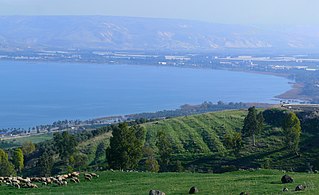
The Sea of Galilee, Lake Tiberias, Kinneret or Kinnereth, is a freshwater lake in Israel. It is the lowest freshwater lake on Earth and the second-lowest lake in the world, at levels between 215 metres (705 ft) and 209 metres (686 ft) below sea level. It is approximately 53 km (33 mi) in circumference, about 21 km (13 mi) long, and 13 km (8.1 mi) wide. Its area is 166.7 km2 (64.4 sq mi) at its fullest, and its maximum depth is approximately 43 m (141 feet). The lake is fed partly by underground springs but its main source is the Jordan River, which flows through it from north to south and exits the Sea at the Degania Dam.

The Dead Sea Scrolls are ancient Jewish religious manuscripts that were found in the Qumran Caves in the Judaean Desert, near Ein Feshkha on the northern shore of the Dead Sea in the West Bank. Scholarly consensus dates these scrolls from the last three centuries BCE and the first century CE. The texts have great historical, religious, and linguistic significance because they include the second-oldest known surviving manuscripts of works later included in the Hebrew Bible canon, along with deuterocanonical and extra-biblical manuscripts which preserve evidence of the diversity of religious thought in late Second Temple Judaism. Almost all of the Dead Sea Scrolls are held by the state of Israel in the Shrine of the Book on the grounds of the Israel Museum, but ownership of the scrolls is disputed by Jordan and Palestine.

The Arabah, or Arava / Aravah, as it is known by its respective Arabic and Hebrew names, is a geographic area south of the Dead Sea basin, which forms part of the border between Israel to the west and Jordan to the east.

The "Seven Seas" is an ancient phrase for all of the world's oceans. Since the 19th century, the term has been taken to include seven oceanic bodies of water:
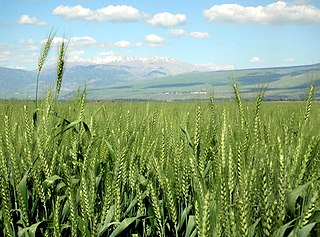
The Hula Valley is an agricultural region in northern Israel with abundant fresh water, which used to be Lake Hula, prior to its draining. It is a major stopover for birds migrating along the Syrian-African Rift Valley between Africa, Europe, and Asia.
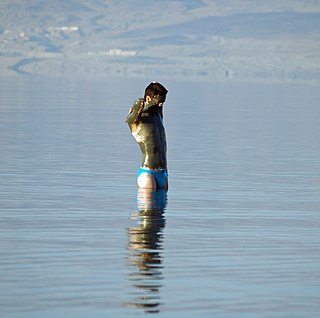
A mud bath is a bath of mud, commonly from areas where hot spring water can combine with volcanic ash. Mud baths have existed for thousands of years, and can be found now in high-end spas in many countries of the world.

Wadi Mujib, which is also "almost certainly" the biblical Arnon Stream, is a river canyon in Jordan which enters the Dead Sea c 420 metres (1,380 ft) below sea level.

A rift lake is a lake formed as a result of subsidence related to movement on faults within a rift zone, an area of extensional tectonics in the continental crust. They are often found within rift valleys and may be very deep. Rift lakes may be bounded by large steep cliffs along the fault margins.
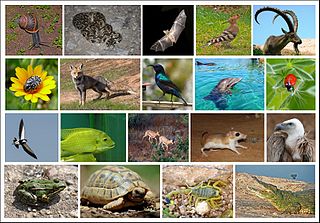
The wildlife of Israel includes the flora and fauna of Israel, which is extremely diverse due to the country's location between the temperate and the tropical zones, bordering the Mediterranean Sea in the west and the desert in the east. Species such as the Syrian brown bear and the Arabian ostrich have become extinct in Israel because of their loss of habitat. As of May 2007, 190 nature reserves have been established in Israel.

Ahava Dead Sea Laboratories, Limited is an Israeli cosmetics company with headquarters in Lod that manufactures skin care products made of mud and mineral-based compounds from the Dead Sea. The company has flagship stores in Israel, Germany, Hungary, South Korea, the Philippines and Singapore. As of 2015, Ahava income was more than US$150 million a year. In 2015, the Chinese conglomerate Fosun International agreed to purchase a controlling share of the company, which has been valuated to ca. NIS 300 million.

World Discoveries III: Dead Sea is a 1999 documentary that takes an in-depth look at the Dead Sea, which is a lake on the border between Israel and Jordan. At 9.6 times saltier than the ocean, the Dead Sea is so salty fish can't swim in it, boats can't sail on it, and animals can't survive around it. The film explores the ominous reputation the salty body of water has acquired and shows slow wide-screen nature shots of its surroundings.

A hypersaline lake is a landlocked body of water that contains significant concentrations of sodium chloride or other salts, with saline levels surpassing that of ocean water.
Geography of the State of Palestine refers to the geographic, climatic and other properties of the areas claimed by State of Palestine.

The State of Israel is one of the smallest countries in the world, around 20,000 sq. km, and has relatively few natural resources. Due to its limited space, semi-arid climate, high population growth and resource scarcity, Israel is highly susceptible to environmental crises. These include water shortages and pollution, shrinking of the Dead Sea, waste production and disposal, air pollution and population density. As a result, resource development, in particular water, has benefited from relatively high government support throughout most of the country's history. For example, Israel's water conservation and reclamation infrastructure is one of the most advanced in the world, with approximately half its water supply derived from reclaimed and treated waste water, brackish water and desalinated water. Additionally, Israel is party to several international agreements regarding air pollution and climate change, including the Kyoto Protocol, the UN Framework Convention on Climate Change and Montreal Protocol. Despite having taken these steps, Israel's environment continues to suffer as a rapidly growing population and standard of living contributes to increasing Green House Gas emissions and air pollutants, reductions in natural and open spaces via urbanization, over-pumping of water sources beyond their replenishment rates and deterioration of water used for drinking and irrigation.


















